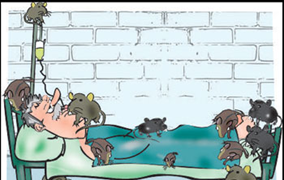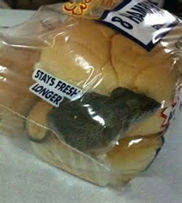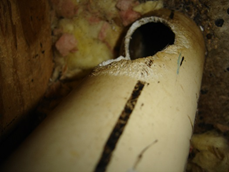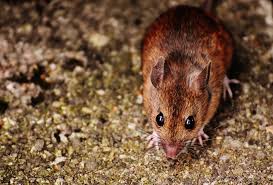Hospitals are supposed to be visiting places for patients, but these days invasive pests too have started visiting them.
Rodents like rats, mice, squirrels etc. are easily found in the areas of hospitals. They are just not found but are known to cause nuisance in the areas of hospitals.
What attracts these pests in the hospitals?
 They get attracted to the food available in the hospital canteens. Caretakers of patients carry food along with them in the hospitals. Many times the carried food is dropped on the flooring. The pest easily gets attracted to these sources of food.
They get attracted to the food available in the hospital canteens. Caretakers of patients carry food along with them in the hospitals. Many times the carried food is dropped on the flooring. The pest easily gets attracted to these sources of food.
There are limited trash bins available in the hospital areas, which get flooded with the trash. The pesky rodents easily get attracted to this.
There are polymeric applications available such as wires and cables, pipes, surgical instruments etc. available in hospitals to which the pests get attracted. The pests are fond of the colors and smell of the polymeric applications which easily brings the pests in the hospitals.
The hospitals provide with a safe nesting area for rodents. The ceilings, decks, laundry areas, kitchens etc. are places where the rodents nest. The atmosphere in the hospitals is preferable for the rodents to rest.
Their nuisance does not stop just damaging the materials from the hospital but also goes up to threatening patient’s lives, and this is for real!
Rats nibble on dead baby’s face in Telangana’s Narsapur hospital
The hospital has denied negligence on its partImage for representation
In a shocking incident, the body of a three-month-old baby was found chewed up by rats in the mortuary at Government Area Hospital in Narasapur in Telangana’s Medak district.
According to reports, the baby girl was identified as the daughter of P Kishan and Surekha. The couple had been living separately due to a family dispute.
The police said that the infant, identified as Gnathi, had been ill for a few days with a high fever, and doctors had referred her to Niloufer Hospital in Hyderabad.
Since it was late on Thursday, the doctors said that an autopsy would be conducted the next day.
When the mother checked on the baby on Friday morning, Surekha found the baby’s face disfigured, as rats had chewed it off.
“Our daughter did not have any marks on her body. She was wrapped in a cloth and taken to the mortuary. I asked for a post-mortem only so that my husband wouldn’t say that I killed our baby due to negligence. I didn’t know it would result in this,” the mother was quoted as saying.
Rats, mice, and wasps discovered inside Walsall Manor Hospital
By Alex Ross | Walsall | News | Published: Feb 19, 2018
Walsall Healthcare NHS Trust used the cash on pest control measures over each of the past four years at Manor Hospital.
A Freedom of Information request asking for details of pest control call outs between 2013 and 2017 revealed the problems faced.
In the 2017/18 financial year there were 10 call-outs. They include rat and mice sightings in the main entrance and clinical measurement unit.
A wasp nest was also discovered in the hospital.
In the financial year before, a mouse was spotted in a ward kitchen and a small insect called a silverfish in another.
Hospitals are sensitive places where patients come to get cure from the diseases they are suffering from. But what when the patients come across the rodents which are carrier of more than 200 deadly pathogens.
The sensitive places like hospitals should be kept rodent free to avoid any mishap due to pest presence.
To keep rodents away from hospitals many ineffective control measures are used traditionally. These methods include the use of rat traps which do not work once a mechanical damage is caused to them. The hospitals are fumigated, which is a most dangerous method of pest control. Glue boards are used that can be dangerous if a patientaccidentallyy sticks to it. Rat poisons are used which are potential of killing the rodents and spreading the death diseases.
In a place likea hospital effective and eco-friendly measures are necessary to keep these pests at a bay.
Is there such a solution available?
Yes, C Tech Corporation’s Combirepel™ is the best solution to keep rodents away from the hospital and hence from human contact.
Combirepel™ is a low-toxic, non-hazardous and rodent aversive. This product works on the mechanism of repellency. It does not harm or kill the target species but generate fear or trigger temporary discomfort within the pests that keep the pests away from the application. The unpleasant experience with the product is imprinted within an animal’s memory and passed on its progeny.
Combirepel™ is available in liquid concentrate which can be diluted in paints and can be applied on interior and exterior of hospitals. The product is safe for use in the patient’s room and operation theatres. The product can be used in the medicine storage areas to keep the pests out of these places. The kitchen and pantry can be painted using this product. The laundry area is dreaded with pests as well where this product can be applied.
The product is available in lacquer form which is a direct application. The lacquer can be applied to the furniture and other wooden accessories used in hospitals. It can be applied on already installed wires and cables, polymeric utility pipes, and equipment used in hospitals. The product is compatible with most of the surfaces like metal, wood, concrete, polymer, ceramic etc.
The product available in the form of masterbatch can be incorporated into the polymeric applications like wires and cables, pipes, equipment and accessories from hospitals while they are manufactured.
Combirepel™ triggers a fear response in rodents thus protecting the application. It causes severe temporary distress to the mucous membrane of the rodents due to which the pest stays away from the application. The product triggers an unpleasant reaction in case if the pest tries to gnaw away the application. After encountering the above-mentioned emotions, the animal instinctively perceives it with something it should stay away from and stores this information for future reference. The fact that certain rodents are repelled is mimicked by other rodents as well. Thus, the other rodents too stay away from the applications. The unpleasant experience is imprinted within the animal’s memory and passed on to its progeny.
The product is compliant with ROHS, ROHS2, ISO, REACH, APVMA, NEA, BPR, and FIFRA exempted.
If you are facing problems from these pests that contact us on technical.marketing@ctechcorporation.com
Also, visit our websites:
http://www.ctechcorporation.com/
http://www.rodrepel.com/
http://www.termirepel.com/
http://www.combirepel.com/
Follow our Facebook pages at:
1] https://www.facebook.com/Combirepel-411710912249274/
2] https://www.facebook.com/Termirepel-104225413091251/
3] https://www.facebook.com/Rodrepel-120734974768048/
Follow us on our Twitter pages at:
1] https://twitter.com/rodrepel
2] https://twitter.com/termirepel
3] https://twitter.com/combirepel

 Fact about all rodents is that they have incisors that never stop growing. They gnaw continuously to keep their choppers in check. Otherwise, their teeth would grow to such an impractical length that they would starve and die.
Fact about all rodents is that they have incisors that never stop growing. They gnaw continuously to keep their choppers in check. Otherwise, their teeth would grow to such an impractical length that they would starve and die. Rodents use their sense of smell to find food. Though herbivorous, they can eat a wide variety of stuff. They eat fruits, vegetables, cereal grains; scavenge for scraps left by a larger predator. Supermarkets provide with a wide variety of food and household products. The main purpose of rodents entering the supermarkets is the food availability there. Here they find a variety of foodstuff to munch, along with a safe place to nest.
Rodents use their sense of smell to find food. Though herbivorous, they can eat a wide variety of stuff. They eat fruits, vegetables, cereal grains; scavenge for scraps left by a larger predator. Supermarkets provide with a wide variety of food and household products. The main purpose of rodents entering the supermarkets is the food availability there. Here they find a variety of foodstuff to munch, along with a safe place to nest. Rodents that seem very big can slide in like a jelly into the tightest of gaps and holes. They can enter supermarkets in many ways like roof joints, electrical cable entry holes, AC chases etc.
Rodents that seem very big can slide in like a jelly into the tightest of gaps and holes. They can enter supermarkets in many ways like roof joints, electrical cable entry holes, AC chases etc. Grains are stored in a lot at supermarkets. These grains become a great treat for the rodents, and insects as well. Grains are mainly stored in burlap or plastic bags, metal or plastic container. Rodents are capable of chewing burlap bags easily, but if given enough time they can chew metal and plastic cans as well.
Grains are stored in a lot at supermarkets. These grains become a great treat for the rodents, and insects as well. Grains are mainly stored in burlap or plastic bags, metal or plastic container. Rodents are capable of chewing burlap bags easily, but if given enough time they can chew metal and plastic cans as well. You can find rats or mice entering your house even when you have designed a rodent-proof house?!
You can find rats or mice entering your house even when you have designed a rodent-proof house?! Many a times rodents gnaw on water supply pipes making holes in them. This results in unnecessary flow and wastage of water.
Many a times rodents gnaw on water supply pipes making holes in them. This results in unnecessary flow and wastage of water. Warehouses: Susceptible to harboring unwanted guests
Warehouses: Susceptible to harboring unwanted guests